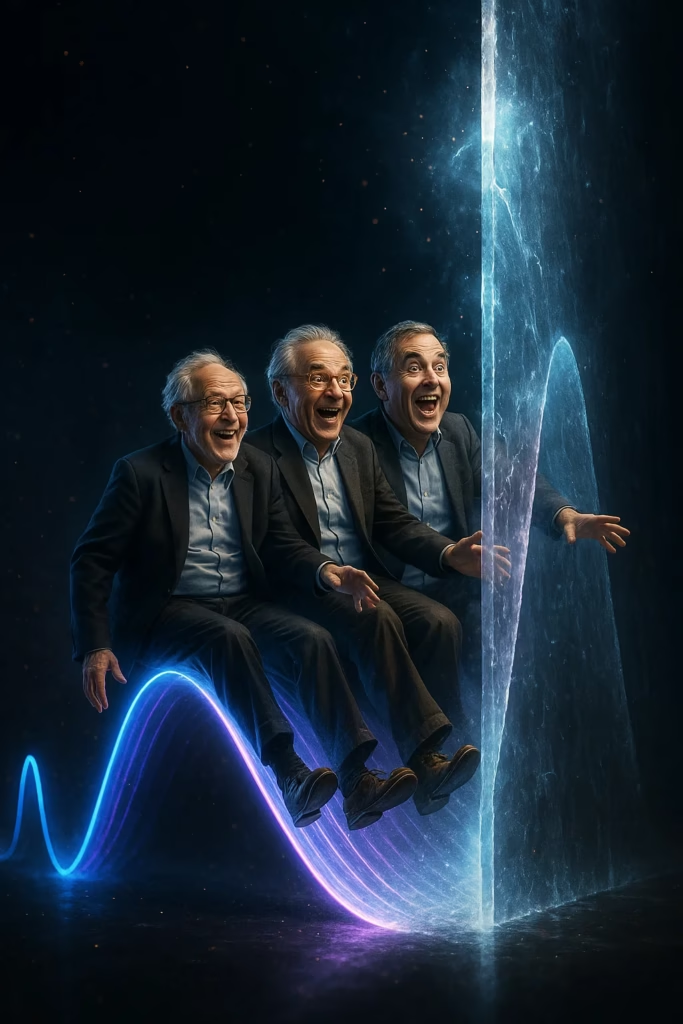The 2025 Nobel Prize in Physics rewards the courage of a thought that believed quantum effects could be seen “with the naked eye” – macroscopically.
Introduction: When the Impossible Became Evident
The renowned John Wheeler, one of the architects of modern physics, said: “If you are not completely confused by quantum mechanics, you do not understand it.” For a whole century, quantum physics spent its time trying to explain and confirm this “bewildering” nature in the micro-world of atoms and particles. While physicists were obsessed with how to “lock quantum effects inside a laboratory test tube,” three researchers believed in something far more courageous: that quantum wonders could also happen in the world we can see and touch.
This year, the Royal Swedish Academy of Sciences has finally acknowledged that vision. The Nobel Prize in Physics was awarded to John Clarke, Michel H. Devoret, and John M. Martinis for their revolutionary 1985 work that experimentally demonstrated macroscopic quantum tunneling.
What is Tunneling? Passing Through a Wall That Isn’t There 🧱➡️👻
To understand the significance of their work, we must understand the phenomenon itself. In classical physics, if you don’t have enough energy to get over a hill, you remain stuck on this side. In the quantum world, a particle (like an electron) behaves both as a particle and a wave. There is a finite probability that it will, like a ghost, “walk through” an energy barrier (the hill) and appear on the other side, as if the barrier never existed.
Until 1985, this effect was well-documented, but exclusively on the atomic and subatomic level. It was a trick performed by electrons in semiconductor P-N junctions (which explains the “dark current” in photodiodes) or a tool for physicists using tunneling microscopes to “feel” atoms. A neat game for the small world.
The Turning Point: The Macroscopic World Wakes Up in a Quantum Dream 🌌
Clarke, Devoret, and Martinis asked a question: What if it’s not about one electron, but billions of electrons behaving as one? What if an entire current, a macroscopic current measurable with an ammeter, could break through an energy barrier?
Their brilliant experiment used superconducting circuits cooled to temperatures near absolute zero. At these temperatures, electrons lose their individuality and merge into a single collective quantum entity – a Cooper pair. This macroscopic quantum function behaves like one gigantic “super-electron.”
When they placed an energy obstacle (a quantum barrier) in the path of this macroscopic current, something incredible happened. The entire current tunneled. Billions of electrons collectively passed through the “wall.” Effectively, a quantum effect occurred on a scale visible to the naked eye (with the help of appropriate measuring equipment, of course).
Why Was This a Tailwind for the Quantum Revolution? 🚀
This work was not just an interesting laboratory curiosity. It was the foundation of the practical quantum revolution.
- Proof of Concept for Macroscopic Quantum Superposition: If a macroscopic current can tunnel, then it can also exist in two states simultaneously (superposition). This is the direct predecessor of the quantum bit or qubit, the fundamental building block of quantum computers.
- The Birth of the Qubit: Building on this work, John Martinis later became one of the leading engineers who designed and built the first practical qubits for Google and others. Their 1985 work was the theoretical and experimental foundation without which today’s quantum processors would not exist.
- A Bridge Between Two Worlds: They showed that there is no sharp boundary between the “quantum” and “classical” worlds. There is a continuum. Our world is deeply, profoundly quantum – it’s just that these effects are usually masked by thermal noise. When you “clean it up” (by cooling), the quantum nature of matter bursts into view.
Conclusion: Recognition for the Courage to Believe the Mind’s Eye 👁️🗨️
This Nobel Prize is not an award for a technical trick. It is an award for the courage of visionaries who believed that physics is unified across all scales. They refused to accept that quantum effects were confined to the invisible micro-world.
Just as Boltzmann believed in atoms when no one could see them, Clarke, Devoret, and Martinis believed in a macroscopic quantum world when it seemed like science fiction.
Their work reminds us of the essence of true engineering and science: that the deepest true principles of nature, when understood, can be harnessed to build the most fantastic technologies. From the tunneling of a single electron to a quantum computer that tunnels through vast data spaces – the path was started by one brave idea.
Inspired by bridges between science and technology? Follow us for deeper insights into the engineering that shapes the future. MilovanInnovation – where ideas turn into progress.


Leave a Reply